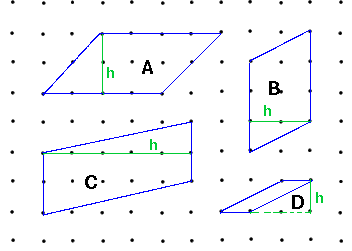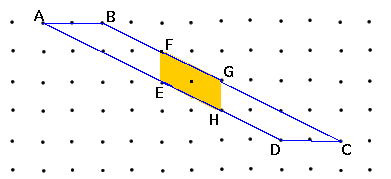 The triangle has area 9, the base is 6 and the height is 3. A = 1/2(6)(3) = 9.
The triangle has area 9, the base is 6 and the height is 3. A = 1/2(6)(3) = 9.
BACK
Next we consider parallelograms. Again the formula is A = bh where b is the base and h is the height. However the base is one side of the parallelogram which, for dot figure purposes, must be either horizontal or vertical, and the height is the distance, vertical or horizontal, to the opposite side. For example, see below, where the heights are indicated.
 For parallelogram A the base is 4, height is 2 so area is 8. For B the base of 3 is on the vertical axis and the height is a horizontal 2 giving us an area of 6. C also has a vertical base of 2 units but a horizontal height of 5 units, this gives an area of 10. Finally D has a horizontal base of 1 unit and a height of 1 unit so the area is just 1.
Now you do some using the figure below:
For parallelogram A the base is 4, height is 2 so area is 8. For B the base of 3 is on the vertical axis and the height is a horizontal 2 giving us an area of 6. C also has a vertical base of 2 units but a horizontal height of 5 units, this gives an area of 10. Finally D has a horizontal base of 1 unit and a height of 1 unit so the area is just 1.
Now you do some using the figure below:

CONTINUE



